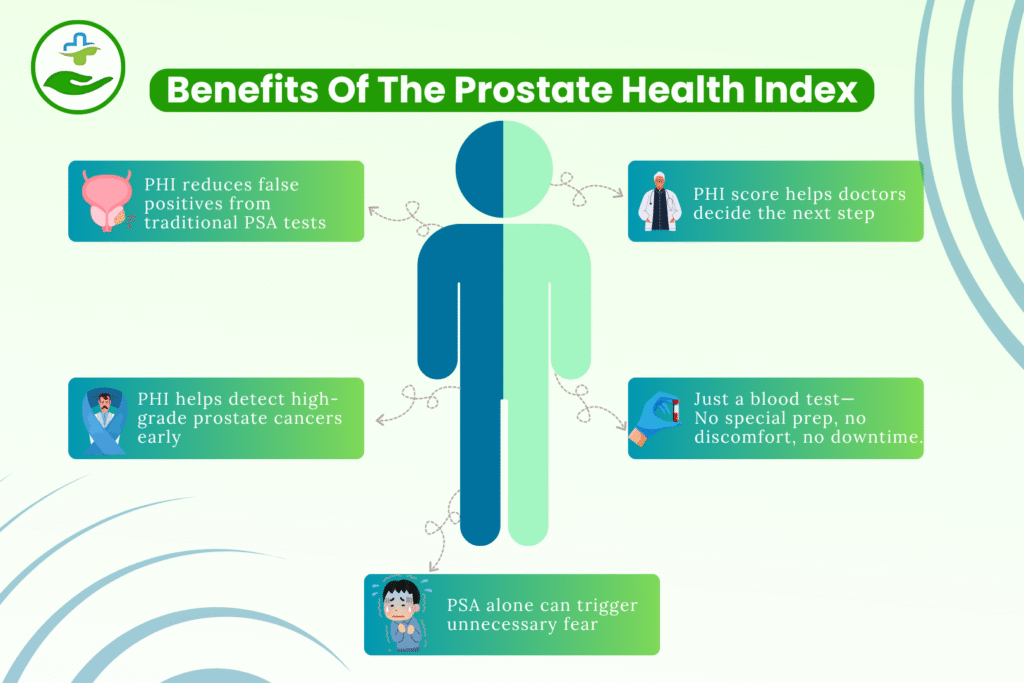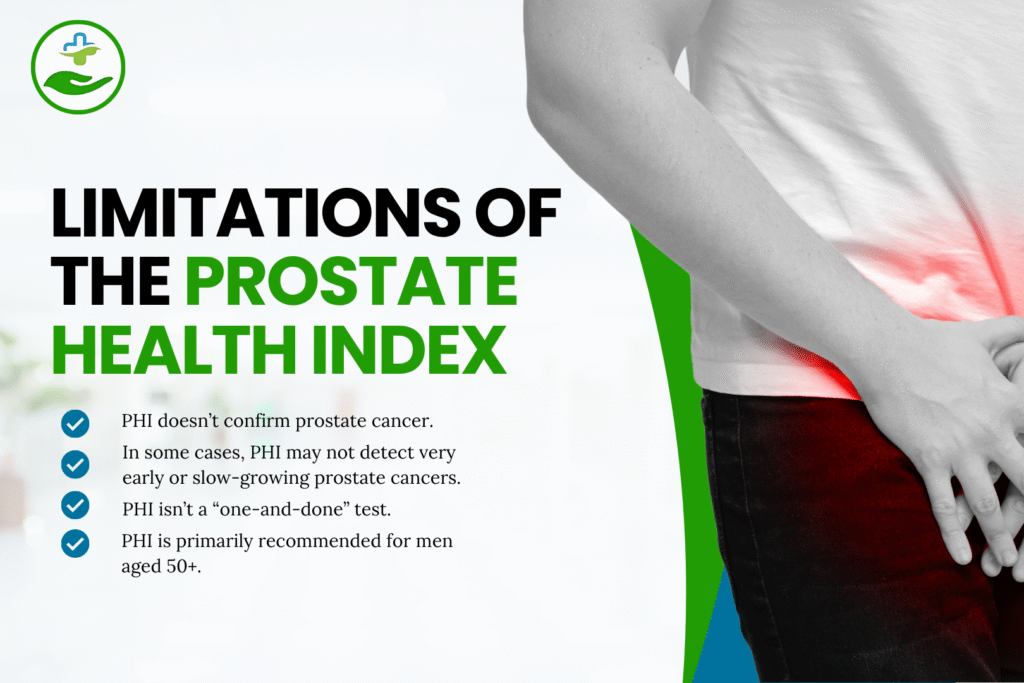Maintaining prostate health is essential for men, especially as they age. Traditional screening methods like the PSA (Prostate-Specific Antigen) test have long been used to detect early signs of prostate cancer.
However, they often come with limitations, such as false positives and unnecessary biopsies. This is where the Prostate Health Index (PHI) stands out.
Offering a more accurate risk assessment, the PHI test helps men and their doctors make more informed decisions. In this blog, we’ll explore the benefits and limitations of the Prostate Health Index, how it works, and whether it’s the right choice for you.
What Is The Prostate Health Index (PHI)?
How The Prostate Health Index Works
The Prostate Health Index is an advanced blood test that combines three types of PSA measurements:
- Total PSA
- Free PSA
- [-2]proPSA (a specific subtype associated with prostate cancer)
These values are combined using a special formula to produce a PHI score, which provides a more precise estimate of prostate cancer risk than PSA testing alone.
When Is PHI Recommended?
PHI is typically recommended for men:
- With elevated PSA levels (especially between 4–10 ng/mL)
- Who are at higher risk due to family history or abnormal digital rectal exams
- When a more accurate risk assessment is needed before deciding on a biopsy
Benefits Of The Prostate Health Index
Improved Cancer Detection Accuracy

Unlike standard PSA tests, PHI is better at distinguishing between:
- Benign prostate conditions (like BPH or prostatitis)
- Aggressive prostate cancer that needs prompt treatment
This means fewer false alarms and more confidence in your test results.
Reduces Unnecessary Biopsies
One of the major advantages of the Prostate Health Index is its ability to reduce unnecessary prostate biopsies.
Since biopsies can be uncomfortable and carry some risks, PHI helps avoid them when they’re not truly needed.
Non-Invasive And Fast
PHI is a simple blood test—no invasive procedures, no downtime. Results are usually available within a few days, allowing for faster follow-up and peace of mind.
Limitations Of The Prostate Health Index

Not A Replacement For Biopsy
While the PHI provides an accurate risk estimate, it’s not a definitive diagnosis. If your score is high, your doctor may still recommend a biopsy for confirmation.
Limited Availability
The PHI test is not yet offered by every laboratory or healthcare provider. Access may be limited based on geographic region or facility resources.
Insurance & Cost Concerns
Some insurance plans may not cover the cost of the PHI test. Patients may need to pay out of pocket, and pricing can vary depending on the lab and location.
Prostate Health Index Vs PSA Test
Here’s how PHI compares to traditional PSA tests:
| Feature | PSA Test | Prostate Health Index (PHI) |
| Accuracy | Moderate | Higher |
| Differentiates Cancer Types | No | Yes |
| Biopsy Reduction | Low | High |
| Cost | Lower | Higher |
| Invasiveness | Non-invasive | Non-invasive |
Who Should Consider The Prostate Health Index?
You may benefit from PHI testing if you:
- Have PSA levels between 4–10 ng/mL
- Have a family history of prostate cancer
- Have had abnormal digital rectal exam (DRE) results
- Want to avoid unnecessary invasive procedures like biopsies
- Are interested in a more personalized and accurate risk assessment
Expert Opinions And Research On PHI
Medical research supports the effectiveness of PHI. Studies show that PHI has:
- Greater specificity than PSA alone
- Better ability to detect high-grade cancers
- Reduced biopsy rates without compromising cancer detection
According to urologists, PHI can be an essential part of modern prostate cancer screening, especially for men in the “gray zone” of PSA levels.
Final Thoughts: Is The Prostate Health Index Right For You?
The Prostate Health Index offers a more precise way to assess your risk of prostate cancer, reducing the chances of unnecessary biopsies and over-treatment. While it’s not a standalone diagnostic tool, PHI is an excellent complement to PSA testing and other evaluations.
As always, speak with your healthcare provider to determine if the PHI test is right for your specific health situation.
Early and accurate screening can make all the difference in prostate cancer detection and treatment.
Frequently Asked Questions
Q1. What is a normal Prostate Health Index score?
Ans- There is no universal “normal” score, but generally, a lower PHI score indicates lower risk. Your doctor will interpret the results based on your age, health, and other risk factors.
Q2. How reliable is the Prostate Health Index compared to PSA?
Ans- PHI is considered more reliable and specific than PSA, especially in the 4–10 ng/mL range, which is often ambiguous in PSA-only results.
Q3. Does insurance cover the PHI test?
Ans-Some insurance plans do cover PHI, but coverage varies. It’s best to check with your provider or the testing lab for specific costs.
Q4. Can the PHI detect all types of prostate cancer?
Ans-PHI is particularly good at detecting clinically significant cancers, but like all screening tools, it’s not 100% perfect.
5. Is the Prostate Health Index FDA-approved?
Ans-Yes, the PHI test is FDA-approved and used by many healthcare providers for more accurate prostate cancer risk evaluation.
Call To Action
Concerned about your prostate health?
Ask your doctor if the Prostate Health Index is right for you, especially if your PSA levels are elevated. Early detection saves lives—get tested with confidence.







